We got sixty CicLAvias now (and The Militant has been to each and every one of them)! The third open streets event of 2025 takes us to a 1.3-mile stretch of Pico Boulevard – once known as “The Backbone of Los Angeles” – in the Pico-Union neighborhood. Formerly known as Pico Heights, what was once a whites-only community by design is now a multicultural neighborhood made up largely of El Salvadoran, Mexican and Korean residents and businesses, with some Greek, Eastern European and African American heritage.
This CicLAmini is a totally new route (though Pico-Union was served by previous CicLAvia routes in April 2013, June 2019 and April 2023) and is not accessible directly by Metro Rail or Bus Rapid Transit lines (Closest you can get is the Wilshire/Vermont station – but it’ll be (B) Line only as the (D) Line will be closed as of Saturday for 70 days to prepare for the upcoming Miracle Mile/Beverly Hills extension (Open! Open! Open!). But what timing, eh?).
As usual — Happy CicLAvia, Go Dodgers, Go Galaxy or LAFC and see you or not see you on the streets!
If you found this Epic CicLAvia Tour guide useful and visit any of these sites, please add the #EpicCicLAviaTour hashtag to any social media post that includes it. The Militant will be glad to re-tweet (speaking of which, don’t forget to follow The Militant on Twitter, Bluesky and Instagram!)!
And if you appreciate The Militant’s work, kick him a little love via PayPal! He *hates* asking for money, but you know how it is these days…A Militant’s gotta pay his bills! He sacrifices a lot of his time to do this! Your support is much appreciated!
Support The Militant Angeleno!
https://www.paypal.com/donate/?hosted_button_id=K5XC5AM9G33K8
Thank you Eddie Arias for your support since the last CicLAvia!

1. Los Angeles Railway P Line/Pico Street Electric Railway
1887
Pico Boulevard between Rimpau Street and Maple Avenue, Los Angeles
Like many CicLAmini routes (the last one being the one through Lincoln Heights last Summer), the alignment is comprised of a streetcar development – where the residential and commercial development along the corridor was made specifically to cater to the streetcar. In this case, for most of its history, it was the Los Angeles Railway’s P Line, whic. ran along Pico from Rimpau Street in Mid-City to Broadway in Downtown Los Angeles (and continued on through DTLA to 1st Street where it ended up in the Eastside’s City Terrace area). It was a Yellow Car line from 1895 to 1963 (Under the Los Angeles Railway 1895-1958; under the Los Angeles Metropolitan Transit Authority 1958-1963). Prior to that, it was the Pico Street Electric Railway, which had a short life of 3 years from 1887 to 1890 and ran along Pico from present-day Harvard Boulevard to Maple Street in Downtown, zig-zagging through DTLA until heading north along Los Angeles Street and terminating at El Pueblo. It was not only the first electric railway built in Los Angeles, but the first one west of the Mississippi. Not only did it serve Pico Heights, it created Pico Heights – the railway was built by the Electric Railway Homestead Association, which sold tracts of land along then-agricultural, then-outlying Pico Boulevard to developers and homesteaders, and built an electric railway from the small, but rapidly expanding city of Los Angeles to the tracts. This land development model was later duplicated (and expanded region-wide) by Henry Huntington for his Pacific Electric and Los Angeles railways.

2. Powers Place – Shortest Street in Los Angeles
1904
Powers Place and Alvarado Terrace, Pico-Union
You all know that the longest street in Los Angeles is Sepulveda Boulevard, right? But the shortest street in the city is right here! It’s called Powers Place, a whopping 30 feet in length! It’s named after onetime Los Angeles City Council president (1900-1902) Pomeroy Powers, who spearheaded the effort to create a city park (originally named Terrace Park) at the neighborhood of Craftsman, Tudor and Victorian-style houses built in the early 1900s decade. All six historic houses along Alvarado Terrace were designated by the City as Historic-Cultural Monuments in 1971.
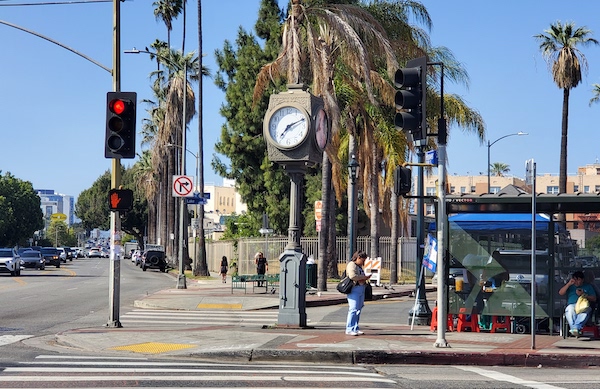
3. Pico/Hoover Clock Tower
1998
Pico Boulevard and Hoover Street, Pico-Union
This clock tower on the northeast corner of Pico and Hoover is the work of the nonprofit Los Angeles Neighborhood Initiative (LANI), which was founded in 1994 as a response to community impact from the 1992 Los Angeles Riots to empower residents underserved neighborhoods in the city to plan development and improvements that will benefit their communities. It was installed in 1998 as part of a streetscape project along with the surrounding plaza, decorative streetlights and street trees to improve walkability, safety and the viability of the small businesses in the neighborhood. Unfortunately, though the clock tower appears in good condition, it’s…uhhh…how should we say it…only correct twice a day, if you know what The Militant is talking about – a common issue with community improvement projects in Los Angeles: there’s money to build it, but no money to keep it maintained (The Militant knows this painfully well with regard to certain projects his mild-mannered real-life identity has been involved in…whoa, has he said too much?).
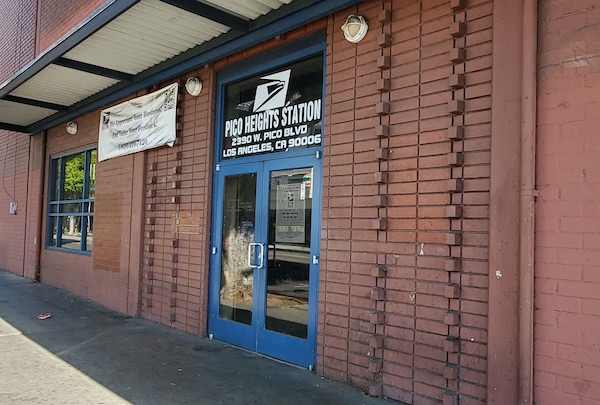
4. Pico Heights US Post Office
c. 1880s
2390 W. Pico Boulevard, Pico-Union
The growing dusty cow town known as Los Angeles required links to the rest of the country and United States Post Office locations were formally established in the 1880s. Back then, the post offices were known by letters (just like today’s Metro Rail and BRT lines, just without any verboten letters due to questionable connotations…). The former “Station J” became the USPS’ Pico Heights Station in 1897, just a year after the Pico Heights neighborhood was annexed by the City of Los Angeles. Over the years the Pico Heights post office moved locations, having previously been located at Pico Boulevard and Menlo Avenue. The current Pico Heights post office has been there since September 1991. Today, the post office’s name is the last visible vestige of the neighborhood known as Pico Heights.

5. Westmoreland Avenue Jacaranda Trees
Date Unknown
S. Westmoreland Avenue, Pico-Union
It’s the middle of Spring, which means the Jacaranda trees are blooming. Though The Militant is all about California native flora, he is well aware that some of all y’allz love them exotic purple sticky trees from South America, so if that floats your boat, check out Westmoreland Avenue just north of the CicLAmini route – there’s a considerable stretch of Jacaranda mimosifolia trees, now blooming, on both sides of the street for your enjoyment.
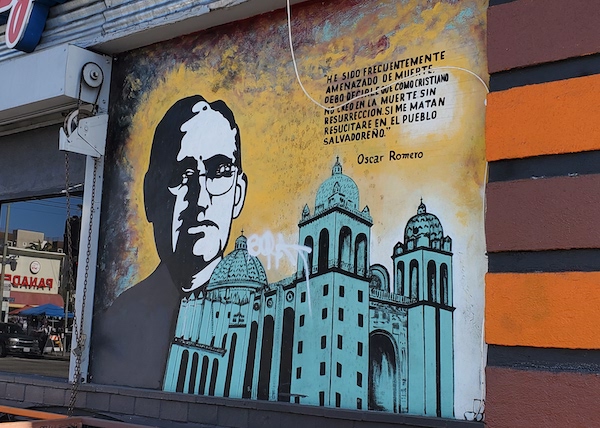
6. El Salvador Community Corridor/Monsignor Oscar A. Romero Square
2010
Pico Boulevard and Vermont Avenue, Pico-Union
Since 2010, the stretch of south Vermont Avenue between 11th Street and Adams Boulevard has been recognized as the El Salvador Community Corridor by the State of California, owing to the large concentration of Salvadoreño businesses and residents who live nearby. In 2012, the intersection of Pico and Vermont was dedicated by the City of Los Angeles as Monsignor Oscar A. Romero Square, honoring the Catholic priest and human rights activist who decried the violence and injustice stemming from El Salvador’s civil war in the 1970s and was later assassinated in 1980, eventually becoming a martyr and national hero among El Salvadorans (and since 2018, officially canonized as a saint). The City of Los Angeles formally designated the El Salvador Community Corridor in 2013. Just a couple blocks north along Vermont is a large weekend tiangue that will be open during CicLAvia that sells various merchandise and Salvadoreño street food.
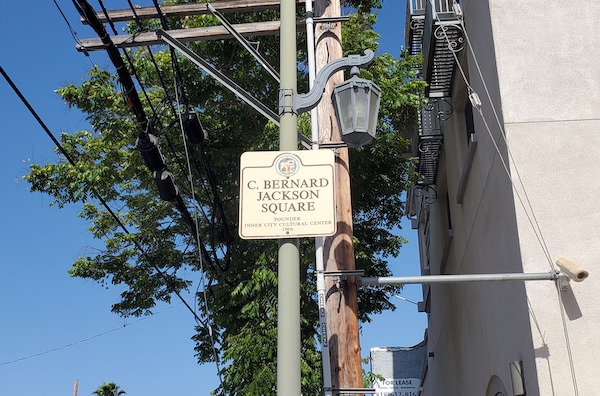
7. C. Bernard Jackson Square
2014
Pico Boulevard and New Hampshire Avenue, Pico-Union
The Los Angeles City historic placard on the southeast corner of Pico and New Hampshire honors C. Bernard Jackson (1927-1996), the African American playwright who founded the Los Angeles Inner-City Cultural Center. Born from the 1965 Watts Uprising, the ICCC has developed and supported multi-ethnic/multi-cultural visual and performing arts productions in the South Los Angeles area since 1966, responsible for establishing the careers of Forrest Whitaker, George Takei and Edward James Olmos. The location for C. Bernard Jackson Square (dedicated by the City of Los Angeles in 2014) was chosen due to the longtime former location of the ICCC, which was at a former Masonic Temple at 1308 S. New Hampshire Avenue (since replaced with the current-day Casa Shalom Apartments low-income housing development) and proximity to Jackson’s residence, which was located nearby.
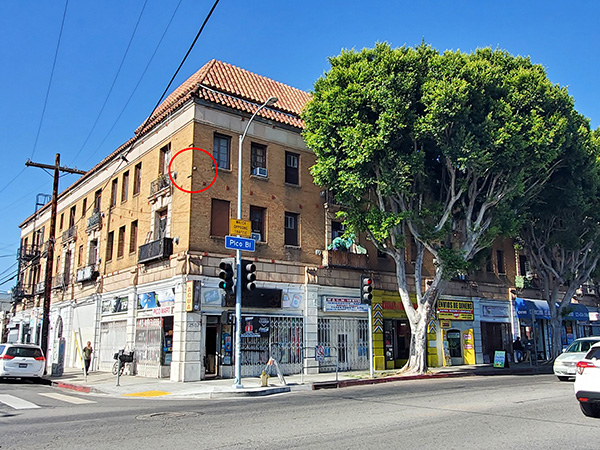
8. Bernard Nesa Apartments/Los Angeles Railway Trolley Wire Eyebolt
1924
2551 W. Pico Blvd, Pico-Union
This 3-story Mediterranean Revival mixed use building built over a century ago is an exemplary glimpse into Pico Boulevard’s streetcar development format. Named after its developer, businessman Bernard Nesa (whatup with all the “Bernard”s on Pico?) who lived from 1866 to 1926, a Swiss immigrant who immigrated to the U.S. in 1889 and settled in Los Angeles in 1910, his name is inscribed on top of the building’s facade. And not only were its apartments and shops designed to accommodate the Los Angeles Railway P Line, but its structure literally was as well – look at the corner of the building on the 3rd story and you’ll see a piece of Los Angeles Railway archaeology: an eyebolt on the building (circled) that was used to support the P Line’s electric trolley wire over the street – one of the few remaining vestiges of the old Yellow Cars on Pico.
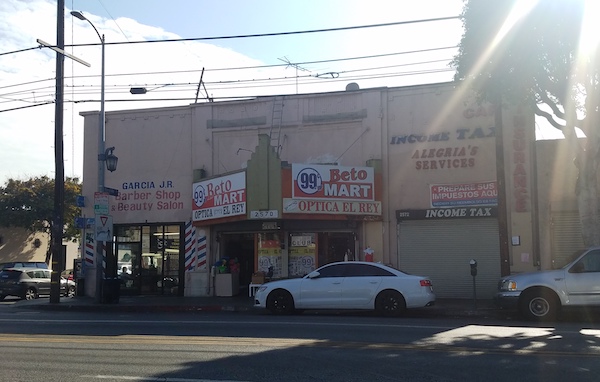
9. Victoria Theatre
1913
2570 W. Pico Blvd, Pico-Union
If you wondered whether the unmistakable art deco-style marquee bearing the signs for Beto Mart and Optica El Rey meant that an old movie theatre was here, you’d be correct: This was once the home of the Victoria Theatre, built in 1913, which for most of its history screened films from Paramount Pictures back in the days when cinemas were owned or affiliated with the big film studios. The 700-seat, single-screen cinema served residents of the old Pico Heights neighborhood until November 1954, after which it was converted into a rental ballroom and venue for meetings in the 1960s. In the 1980s it was a concert venue for local bands before its theatre interior was gutted and made into today’s commercial storefront.
10. ‘Unfinished Sympathy’ Music Video Location
1991
1311 S. New Hampshire Avenue to 2632 W. Pico Boulevard, Pico-Union
The music video to the 1991 underground hit “Unfinished Sympathy” by UK trip-hop/electronica group Massive Attack was filmed right here along the CicLAvia route. The video, directed by Baillie Walsh is comprised of a steadicam-shot single take featuring singer Shara Nelson walking westbound along the south side of Pico Boulevard (the members of Massive Attack – one of whom may or may not be guerrilla street artist Banksy – cameo as people walking behind her). Cameraman Dan Kneece, who also filmed the late David Lynch’s 1986 film Blue Velvet, operated the steadicam and filmed it at a slightly-faster speed, slowed down to normal speed in post-production to give a slo-mo effect. It’s amusing to note that after nearly 35 years, the street has not changed that much since this video was taken.

11. Papa Cristo’s Taverna/C&K Importing Co.
1948
2771 W. Pico Boulevard, Byzantine-Latino Quarter
In the first half of the 20th century, this stretch of Pico Boulevard was known as Los Angeles’ “Greek Town.” Greek immigrant Sam Chrys established C& K Importing Company at Pico and Normandie in 1948 to import food and ingredients from the motherland to members of the community on this side of the country. In 1968, his son Chrys Chrys (a man so nice, he was named twice) took over the business and in 1990, he established Papa Cristo’s Restaurant, serving Greek cuisine using the ingredients imported by C&K. After getting Hellas love by Angelenos for 77 years, Papa Cristo’s closed down for good on May 4, 2025 due to rising rents and the property’s landlord putting the property up for sale for redevelopment. The business, currently run by daughter Annie Chrys, continues in a limited capacity online, and may or may not re-open the restaurant at a new location in the near future.
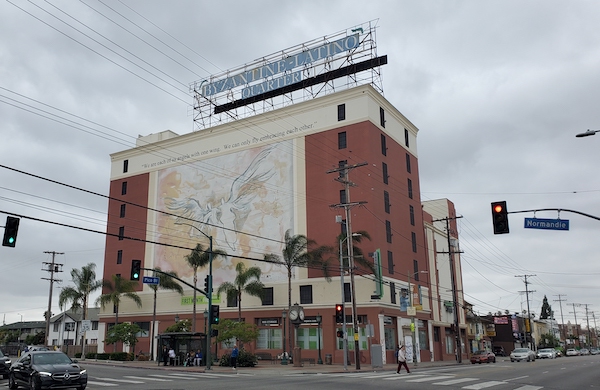
12. Byzantine-Latino Quarter
1997
Pico Boulevard and Normandie Avenue, Byzantine-Latino Quarter
With the western end of Pico-Union having been a historically Greek and Eastern Europan immigrant neighborhood in the first half of the 20th century, later becoming a predominantly Mexican and Central American immigrant community since the 1970s, various local institutions, community leaders, businesses and residents banded together to establish the Byzantine-Latino Quarter in 1997, centered around the cultural and ecumenical ties between the congregations of St. Sophia’s Greek Orthodox Cathedral and neighboring St. Thomas the Apostle Catholic Church. The BLQ’s boundaries – formally recognized by the California State Assembly, but not the City of Los Angeles – comprise of 11th Street on the north, Venice Boulevard on the south, Hobart Boulevard on the west and Alvarado Street on the east – which overlap with the City’s formally-recognized domain of the Pico-Union community. In 1999, the BLQ redeveloped the southwest corner of Pico and Normandie into the BLQ’s signature landmark, featuring a towering “Angels” mural painted on the eastern wall of the Extra Space Storage building by artist Christopher Ulrich, topped by a bright neon sign bearing the area’s name, with a LANI-created public square (which features an identical clock tower as the one on Pico and Hoover – which…uhhhh…also is only correct twice a day).
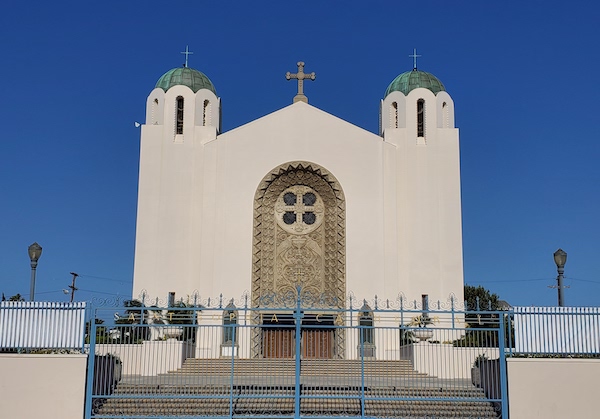
13. St. Sophia’s Greek Orthodox Cathedral
1952
1324 S. Normandie Avenue, Byzantine-Latino Quarter
Although immigrants from Greece have been living in Los Angeles as a community since the 1890s (initially centered in the Boyle Heights area), a second wave arrived between the 1900s and 1930s decades, many of whom called the Pico Heights area home. Though Greek Orthodox have been practicing their religion in Los Angeles formally since 1906, it wasn’t until 1952 when a permanent church building was established, thanks to the resources of the Skouras brothers – all executives at major motion picture studios (Charles and Spyros Skouras at 20th Century Fox and George Skouras at United Artists), who vowed to help build a Greek Orthodox Cathedral for the community. Named after the 2nd century Roman martyr, the Byzantine Revival cathedral, which seats 750 congregants, remains the spiritual and cultural heart of the Greek community in Los Angeles, hosting the annual L.A. Greek Festival every October on its grounds and along Normandie Avenue. It was designated Los Angeles Historic-Cultural Monument #120 in 1973.
Did you enjoy this guide? Learned something new? Kick The Militant Angeleno a little love via PayPal!
Support The Militant Angeleno:
https://www.paypal.com/donate/?hosted_button_id=K5XC5AM9G33K8

You must be logged in to post a comment.